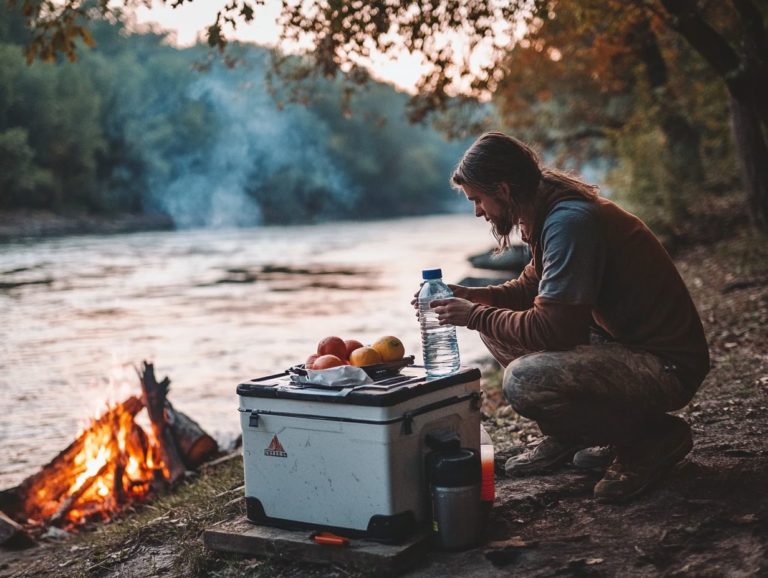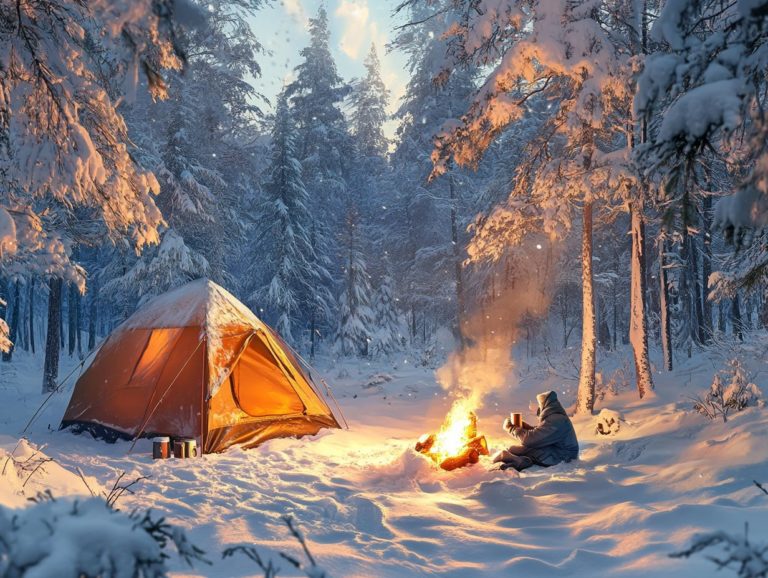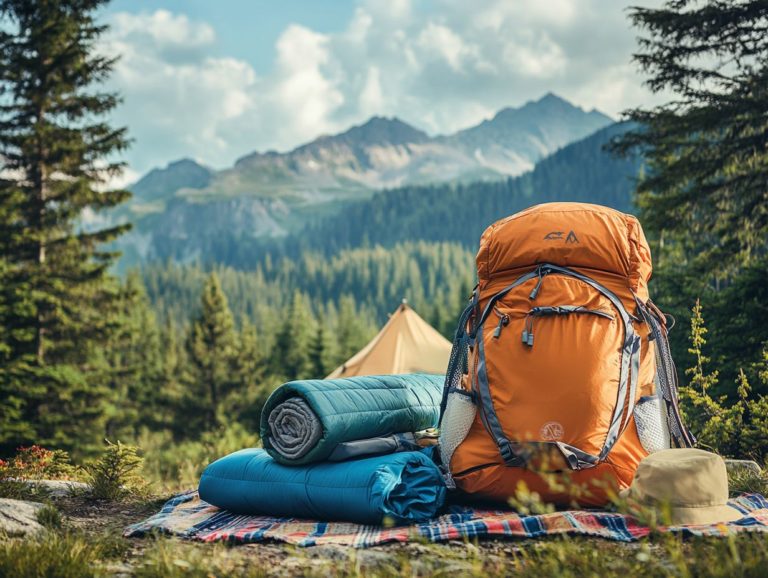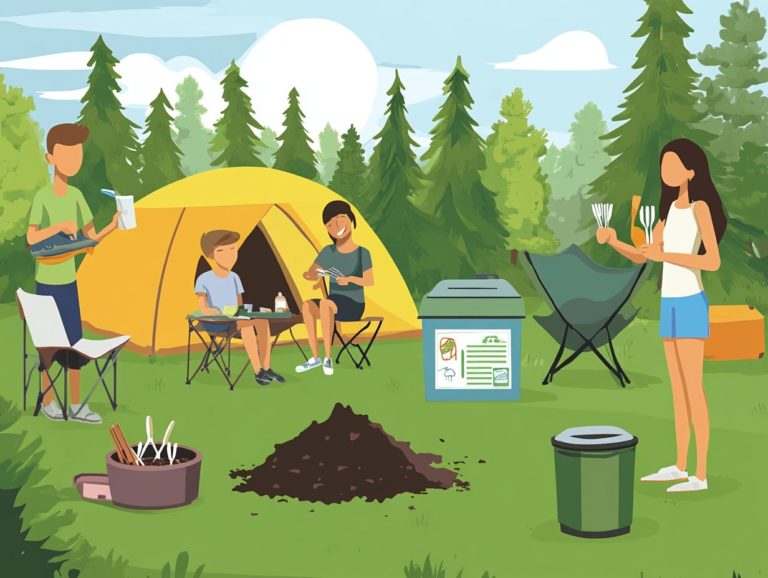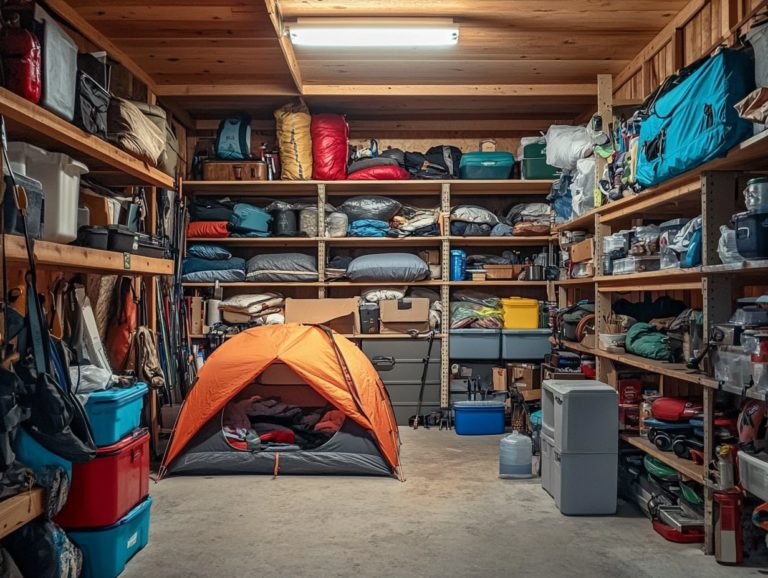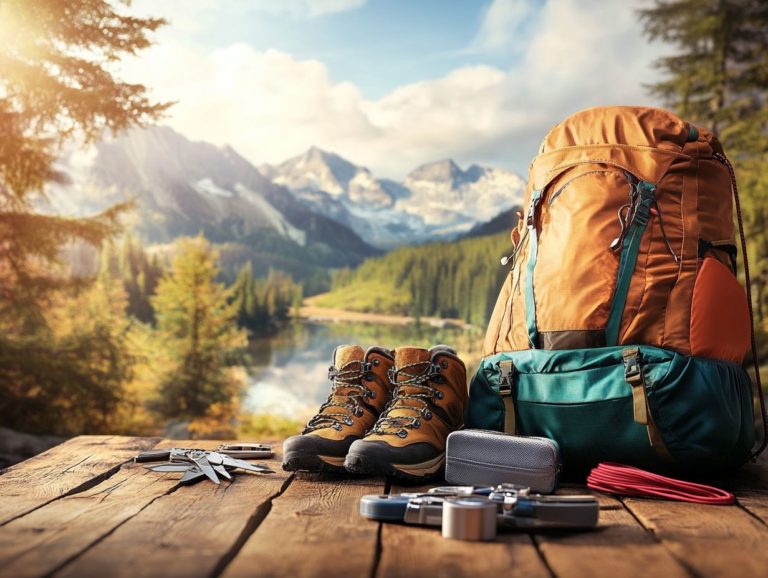Staying Safe in Bear Country: Camping Tips
Camping in bear country can be an exhilarating adventure, yet it presents its own unique challenges. Staying aware of your surroundings is essential for safety.
Understanding bear behavior is essential for ensuring your safety and maximizing your camping experience in the wild. This guide provides you with vital insights into different bear species, such as the Black Bear and Grizzly Bear, and their habits. You will also discover effective preparation tips and the right gear you ll need for a safe camping experience.
You ll learn how to choose a safe campsite and proper food storage techniques. Knowing what to do in the event of a bear encounter can help mitigate the risk of injury or attack. You will also learn emergency procedures for unexpected moments, ensuring personal safety and proper reporting of any bear activity.
Arm yourself with this knowledge to enjoy a safer and more rewarding camping trip! Remember, the key is to stay calm and maintain your space.
Contents
- Key Takeaways:
- Understanding Bear Behavior
- Preparing for Bear Country
- Campsite Selection and Setup
- Food Storage and Handling
- Encountering a Bear
- Emergency Procedures
- Frequently Asked Questions
- How can I stay safe while camping in bear country?
- What should I do if I encounter a bear while camping?
- What are some important items to bring when camping in bear country?
- Can I have a campfire while camping in bear country?
- Are there any specific safety precautions for camping with children in bear country?
- What should I do if a bear enters my campsite?
Key Takeaways:
- Understand bear behavior in different regions to better prepare for camping in bear country.
- Always bring essential gear and supplies, such as bear spray and containers that bears can’t open, to ensure safety.
- Choose a safe campsite and properly set up bear deterrents, such as secure food storage and designated cooking areas, to minimize the risk of encountering a bear.
Understanding Bear Behavior
Understanding bear behavior is essential for anyone in bear country, whether you’re camping, hiking, or simply passing through renowned National Parks like Yellowstone, Alaska, or California.
Bears, including black bears and grizzly bears, display many different behaviors influenced by their environment and human presence, especially in backcountry areas. This awareness is crucial for your safety and helps prevent encounters that could escalate into aggressive interactions. Always remember to respect their space and respond calmly.
By recognizing these behaviors, you enrich your wilderness experience. You also equip yourself with the knowledge necessary for taking effective precautions and responding appropriately in the rare event of an encounter with a bear.
Types of Bears and Their Habits
There are various types of bears you might encounter, notably the black bear and the grizzly bear. Each exhibits unique habits and behaviors affecting interactions with humans and their environments.
Take the black bear, for instance. These creatures often roam the forests and mountains of Colorado or the expansive wilderness of Montana, living a generally solitary life. They enjoy a diverse diet, foraging for fruits, nuts, and insects during the vibrant spring and summer months.
On the other hand, you’ve got the grizzly bear, commonly seen in the rugged terrains of Montana, Idaho, and parts of Wyoming. These bears show more complex social structures and how they defend their area, especially during mating season, which is crucial for cub survival. They establish dominance over vast territories, leading to intriguing social dynamics as they compete for food sources like salmon and berries.
Preparing for Bear Country
Preparing for bear country is crucial for anyone venturing into the outdoors whether you’re camping, hiking, or soaking in stunning landscapes of bear-populated regions like national parks and backcountry areas.
To ensure a safe and enjoyable experience, it’s vital to understand bear safety protocols and choose appropriate gear. Implement precautions that minimize the likelihood of encounters. Equipping yourself with essential items such as bear spray, bear canisters, secure food storage containers, and comprehensive safety kits greatly elevates your level of protection against potential bear encounters, allowing you to embrace the adventure while keeping safety at the forefront.
Make your next camping trip unforgettable! Get prepared today for a thrilling adventure in bear country!
Essential Gear and Supplies
When you venture into bear territory, having the right gear and supplies is essential for ensuring your personal safety and minimizing the risk of unexpected bear encounters.
Equipping yourself with crucial tools, like bear spray, can be a game-changer in tense situations. It serves as a vital deterrent that can make all the difference. Using bear canisters for food storage is another smart move; these containers are designed to keep bears out and help prevent them from getting used to human scents.
Practicing proper food storage techniques is key, as it significantly decreases the chances of attracting bears, ensuring a safe camping experience. Incorporating safety equipment, such as whistle devices, allows you to alert nearby hikers to any potential threats.
Together, these items create a safer outdoor experience by promoting responsible camping and hiking practices, ultimately enhancing your protection against aggressive bear activities.
Campsite Selection and Setup
Choosing and setting up a campsite in bear country demands careful attention to ensure safety and minimize the chances of bear encounters. It s essential to select a suitable site by understanding the environment, including nearby bear habitats and food sources, to maintain a safe distance from potential encounters.
Consider how you arrange your campsite to effectively deter bears. Implementing strategic safety measures can foster a serene atmosphere, paving the way for a more enjoyable camping experience.
Choosing a Safe Campsite
Choosing a safe campsite in bear country is essential to avoid unwanted encounters and create a secure environment for your camping adventure.
Be on the lookout for signs of local wildlife, especially indications of bear activity, such as tracks or droppings. Steer clear of areas marked with bear warning signs and set up your site at least 200 feet away from food storage locations. Staying this distance can dramatically lower your chances of an encounter!
Being aware of your surroundings is vital. Remain alert to the natural world, especially for signs of bear activity like tracks or scat. Observe the behavior of local animals to gain insights into bear behavior and movement.
By effectively selecting your campsite and cultivating wildlife awareness, you can greatly enhance your overall outdoor experience.
Setting up Bear Deterrents
Effective bear deterrents are crucial when camping in bear territory, ensuring that your wilderness experience is both safe and secure. These measures not only boost your personal safety but also reflect responsible camping practices.
Consider utilizing bear spray, which can be a real game-changer in deterring bears during an encounter. Bear-proof containers are also essential for keeping your food secure. Employing proper food storage techniques such as hanging your food at least 10 feet high in trees is critical for minimizing attractants.
Noise-making devices, like bells or clangs, alert nearby bears to your presence, significantly reducing the chance of surprise meetings. Familiarizing yourself with bear behavior, especially their foraging habits, can greatly enhance your ability to maintain a safe environment.
Food Storage and Handling
Proper food storage and handling are essential when camping in bear country. Neglecting these practices can increase the risk of bear encounters and potential attacks.
By prioritizing safe methods, you can significantly reduce the likelihood of attracting bears to your campsite, ensuring a calm and enjoyable experience. Do not risk your safety follow these food storage guidelines to keep bears at bay!
Proper Food Storage Techniques
Mastering food storage techniques can make your camping adventures worry-free! Implementing proper food storage practices is crucial for preventing bear encounters while camping in bear country.
By using bear canisters special containers that keep food safe from bears hanging food bags, and other secure containers, you can significantly reduce the likelihood of unwanted visits from these majestic yet potentially dangerous animals.
Bear canisters are particularly effective; they are designed to withstand even the most determined bear attempts to access their contents, making them a reliable choice for keeping your food safe during outdoor activities.
Hanging food bags at a suitable height and distance from your campsite can also deter curious creatures, enhancing your overall safety and helping to maintain a peaceful camping environment. These methods not only protect your valuable food supplies but also contribute to a more enjoyable camping experience.
Preparing and Cooking Food
Preparing and cooking food in bear country requires caution and awareness to prevent attracting bears to your campsite.
Maintaining a clean cooking area is vital. Make it a habit to wipe down surfaces and sanitize utensils regularly, ensuring no food residue lingers, which could attract bears and other wildlife.
By keeping your sleeping areas separate from food preparation zones, you significantly reduce the chances of bears investigating your camp, creating a safer environment for your group.
For food waste disposal, using bear-proof containers is essential. These should be tightly sealed and stored far from where you sleep.
To minimize odors, double-bag any organic waste and dispose of it promptly in designated areas. This simple action helps avoid attracting bears and contributes to a more peaceful camping experience.
Encountering a Bear
Encountering a bear can indeed be a daunting experience, yet knowing the right safety measures can significantly reduce risks and foster a more serene interaction.
Dos and Don’ts in a Bear Encounter
Knowing the dos and don’ts of a bear encounter can greatly enhance your safety.
- Stay calm and avoid sudden movements.
- Make some noise to alert the bear to your presence, giving it a chance to retreat.
- Never run or turn your back on the bear; this might trigger its predator instincts.
By understanding bear behavior, you can navigate these tense moments more effectively, ensuring safety for both yourself and the bears.
Emergency Procedures
In case of a bear attack, knowing emergency procedures is vital for safeguarding your personal safety and minimizing potential injuries.
Knowing how to report after an incident is also crucial for effective communication and response.
What to do in Case of an Attack
Knowing how to respond in the event of a bear attack is crucial for your survival and can influence the outcome.
Understanding the type of bear be it a black bear or a grizzly can shape your response strategy. If faced with an aggressive black bear, it s often recommended to retreat slowly while maintaining eye contact, as they typically prefer to avoid confrontation.
If you encounter a grizzly bear, especially one with cubs, playing dead may enhance your chances of survival.
Always maintain awareness of your surroundings and steer clear of areas with recent bear activity. Carrying bear spray is another essential safety measure. Familiarizing yourself with emergency procedures can greatly improve your preparedness and significantly boost your odds of escaping a perilous situation.
Frequently Asked Questions
How can I stay safe while camping in bear country?
Stay safe in bear country by properly storing food and scented items. Avoid traveling alone and make noise while hiking.
What should I do if I encounter a bear while camping?
If you see a bear, remain calm. Slowly back away, keeping your eyes on the bear without making sudden moves.
If the bear continues to approach, make yourself look as big as possible. Shout and throw objects, and use bear spray if necessary. Bear spray is a type of pepper spray designed to deter aggressive bears. It s important to carry it when camping.
What are some important items to bring when camping in bear country?
Some essential items for camping in bear country include bear spray, bear-proof containers for food and scented items, a whistle or noise maker, and a first aid kit.
Can I have a campfire while camping in bear country?
Campfires can be a cozy addition to your camping experience, but check local rules first! It’s important to properly extinguish the fire before leaving the campsite.
Are there any specific safety precautions for camping with children in bear country?
When camping with children in bear country, educate them on bear safety. Keep children close and make noise while hiking. Properly store all food and scented items.
What should I do if a bear enters my campsite?
If a bear enters your campsite, stay calm! Make loud noises to scare it away. Do not attempt to approach or feed the bear.
If the bear does not leave, slowly and carefully back away while facing the bear and seek assistance from park or forest rangers.

